Today is going to be extra special. Not only are we going to take a bit of a trek in the new Mercedes-AMG SL 55, in itself a treat, but we are also going to drive out to meet a legend. Our journey starts in Rajkot, at the centre of Gujarat, after which we’ll make our way south to the erstwhile princely state of Gondal. We won’t just be going south in our sojourn, we’ll also be sort of going back in time, to an earlier, more romantic age.
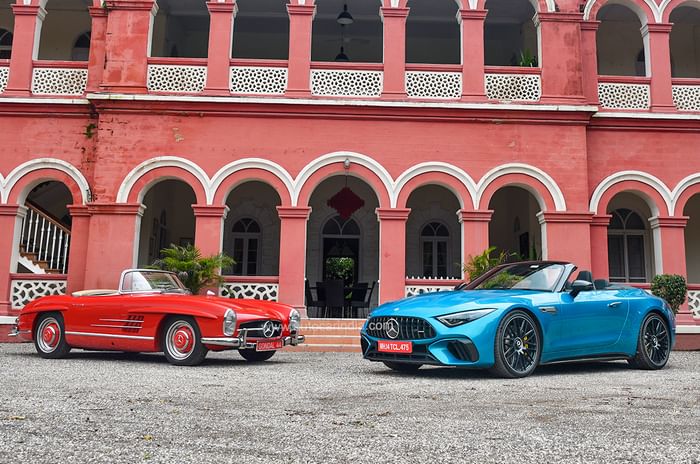
The car we are going to meet is the legendary 300 SL, the first SL drop-top, the one that in many ways started it all. This also isn’t just any 300 SL; this car has a unique provenance and history. But more on that later, let’s get on the road.
Testing times
The sun’s out as we exit Rajkot airport and the road to Gondal appears to be a wide four-lane highway. We’ll get some narrow village roads towards the end, but this should be loads of fun.
I open the boot to toss my bag in, but there’s no space. Yes, the boot has around 200 litres of space, but most of that is taken up by the all-important spare tyre, something this car isn’t originally designed to carry. Luckily, I only have a soft bag, and that goes straight onto the rear seat behind me. Remember, the SL 55, like a Porsche 911, is a two plus two, the ‘plus two’ signifying two smaller rear seats.
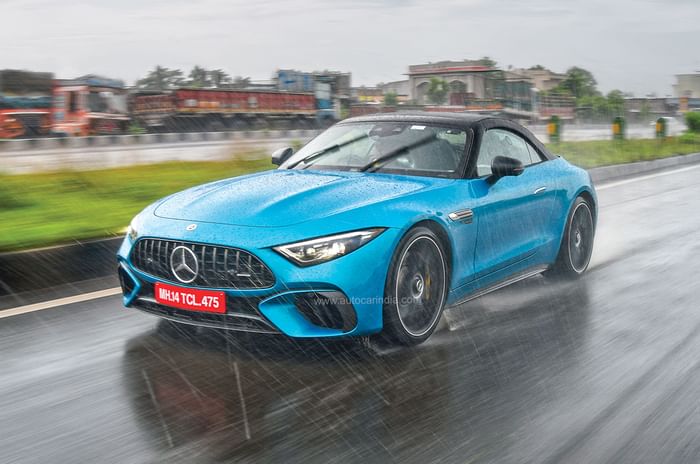
On the way out from the airport, we scout around for some good fuel as we’re not sure what octane we’ll get further up the road. Finally, tank brimmed with 95, we head out. As we approach the highway, we encounter some really large speed breakers. Now, the SL 55 gets an optional nose lift feature at Rs 6 lakh, and it’s something you must get. Despite this, I crawl over some of the larger speed breakers at an angle; you can never be too careful. Making it out to the highway also isn’t an easy exercise. Bikers swarm around the car, we have many bad patches of road to traverse and then, making it through the outskirts of Rajkot needs some seriously defensive driving. I have “pehle aap, pehle aap” on repeat in my head. And then it begins to rain hard. Really hard.
Going the distance
Now, part of the charm of driving this car over long distances is that the SL has always been both a sportscar and a comfy GT rolled into one. This has always been a car you can drive out to pretty much anywhere, and this, to some extent, is true here as well. First impressions, roof up, are of a car that is pretty well insulated and refined on the inside. We often forget how good modern convertibles are. Yes, the triple layer roof does let in more noise than a hard top, but what it also does successfully is muffle outside sounds and that, in essence, makes using it on regular journeys like this a pleasure. The tight-fitting roof, however, does make you feel quite hemmed in and, in some ways, makes the SL feel even more compact than it is. Convertibles in India are used roof up for the majority of the time, as opportunities to open them are few and far between.
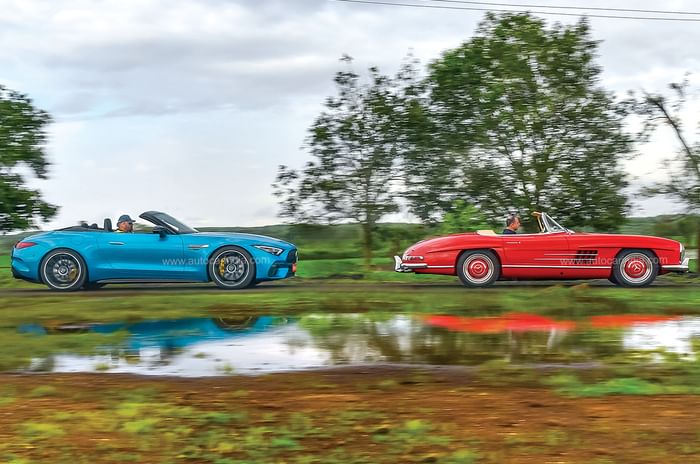
On our way out, we also cross some not-so-perfect roads, and it’s here that the new sportier suspension set-up of the SL becomes apparent. Even set in Comfort, there’s a clear edge to the set-up and the stiff suspension makes its presence felt. The ride isn’t bone-jarring, but I am still aware of sharp-edged bumps and bad sections. And what makes it worse are that the seats are hard. The ride quality, however, improves as soon as we are on the highway. Higher speeds iron out the ripples better and visibility from the SL is superb, which makes it easier to spot bad patches; important as I’m always looking for an opportunity to flex my right foot.
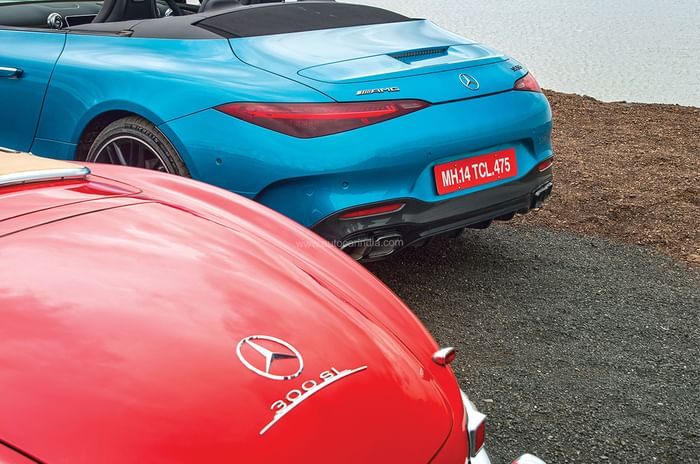
Under the muscular hood of the SL 55 is an equally buff 476hp, 700Nm, 4-litre, twin-turbo V8. So when gaps in traffic open up and the road is acne- and crater-free, I exercise the whip-like right pedal. Even pushing the pedal down past 60 or 70 percent delivers an overwhelming surge of raw thrust. And then, once I click down to the right gear and really plant my foot, the four wheels just dig in with a vengeance and launch the SL forward like a missile. This is in the wet, and what makes the experience even more heady is AMG’s signature exhaust rumble; well-timed pops and bangs on overrun playing the perfect supporting role. Once the four laner opens up, what I also appreciate about the SL are the long legs the nine-speed box gives it. When cruising, the big V8 drops to just above idle speeds and feels absolutely effortless.
The new SL, however, is now more of a bruiser than a cruiser, the dial clearly turned more towards the Sporty end. The change in character can be explained in part due to the model’s shift from Mercedes to AMG – Merc’s performance brand now responsible for developing the car. A shift in thinking and objectives mean the SL now gets an all-new platform, one that’s completely different from the GT line. The clean sheet design consists of an aluminium space frame aided by what AMG calls a self-supporting frame. The increase in overall rigidity is substantial, says AMG. For greater grip and traction, the SL gets AMG’s 4Matic+ or all-wheel drive – a first for the SL. And then to help make it dance and dart into corners with greater agility, there’s rear-wheel steering, something normally used on long wheelbase cars to help them turn better.
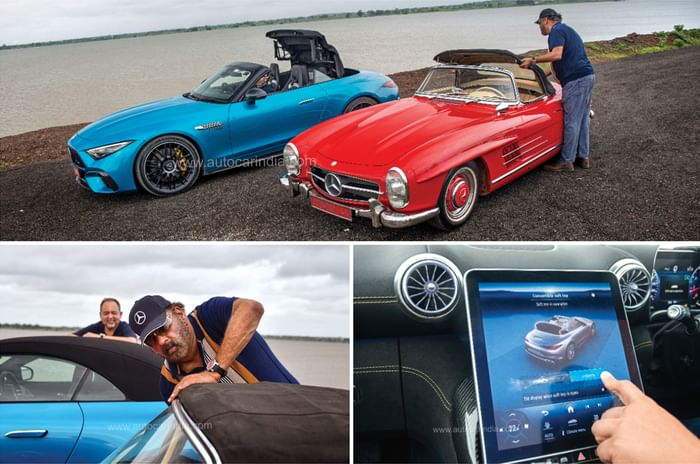
In keeping with the original SL script, this new seventh-gen car gets a fabric roof instead of a folding hard top. This saves 21kg over the earlier hardtop; still, the SL weighs in at upwards of 1.9 tonnes, a far cry from the 300 SL’s 1.3 tonnes.
As we branch out towards Gondal, we pass some delightfully empty country roads that gently twist and turn through rural farmland. The rain has stopped, so I drop the roof and this now really allows me to experience the SL to the fullest. Once I get into the grove, muscular performance apart, what really endears me to the SL 55 is how compact and agile it feels. The rear-wheel steering makes it feel like it is the size of a Mercedes-Benz SLK, and the four-wheel-drive system allows me to put down huge gobs of power as I exit corners, this is an intense and locked-down driving experience. The steering even transmits the tug the front wheels experience when you really put the power down. Can’t shake the feeling that this is what a modern-day four-wheel-drive AC Cobra would feel like; muscular, compact, brutal.
Time travel
Our drive to Gondal is now coming to an end, and soon it will be like going back in time. The roads that lead through the village are wide and surprisingly well-laid-out, and as we make our way to the palace of the erstwhile ruler of the state, we pass all manner of public works and infrastructure built prior to 1947.
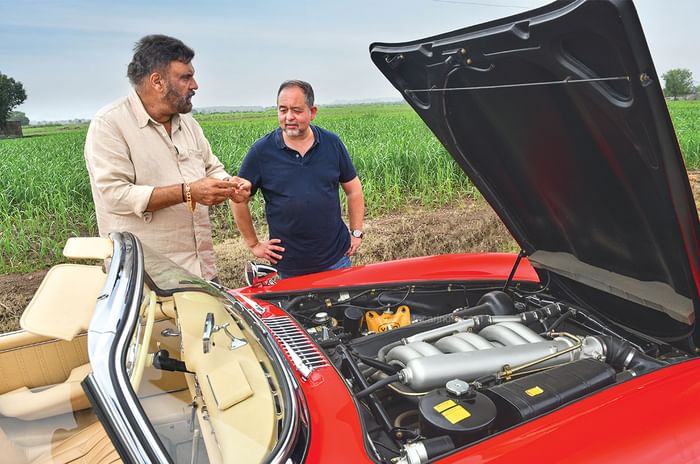
The car we have come all the way up to see is easily one of the most sought-after classics in India, the 300 SL convertible from the late ‘50s. Valued today at upwards of a million-and-a-half US dollars (over Rs 10 crore), the roadster followed the famous gullwing. An evolution of the gullwing (W198 I), but with a new, taller headlight, an improved new rear suspension and plenty of other significant updates, this car (W198 II) is also clearly a direct descendant of the W194 or the gullwing race car.
As I drive the SL 55 into the well-manicured lawns and park, I see the stunning red 300 SL parked against the backdrop of the palace. Yes, this car has been with royalty since new and His Highness Himanshusinhji of Gondal, the owner of the car is there to greet us. The conversation soon switches over to the red piece of automotive art. I particularly like the tall headlights, I love how Mercedes tilted the engine over and lowered the bonnet (for aero, not style). And aren’t those ‘brows’ over the wheel arches epic?
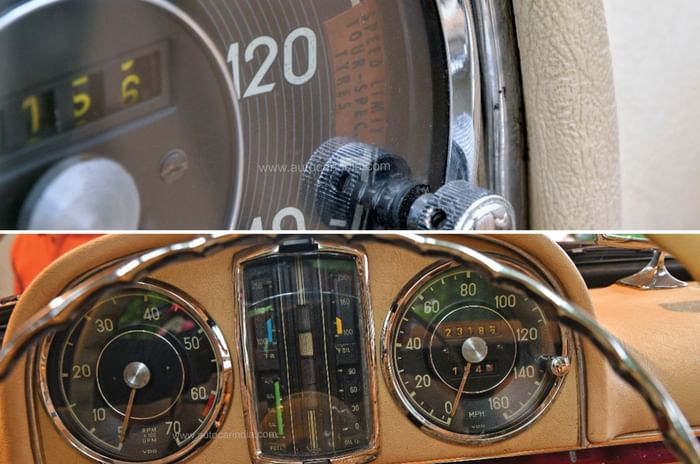
I’m itching to drive the 300 SL again and His Highness Himanshu (just ‘Hima’ to friends) is kind enough to hand me the keys; he’ll follow in the SL 55. As the owner of an SLS, GT roadster, GT and half a dozen other AMGs, his perspective will be fascinating. And what helps is that Hima is also a full-on petrolhead who works on his cars himself.
Getting reacquainted with the cabin of the 300 SL again is pure joy. Love those big white-on-black clocks on the instrument panel, the chrome switchgear functions with a solid click-clack, and the manner in which the body colour is visible on the dash, with the leather-covered top and bottom just hits the spot. Clambering over the wide sill, where the tubular chassis runs through (why Merc had to use gullwing doors in the first place on the coupe), is difficult, but what surprises me is just how comfortable and low-slung the seating position feels. And the round seat back offers good lateral support.
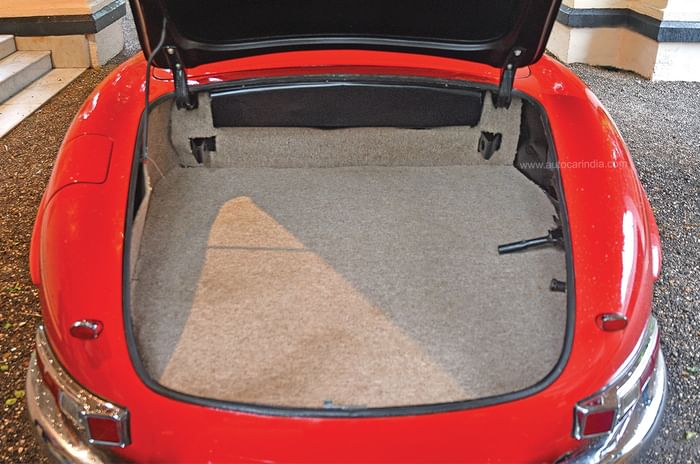
Dream it, drive it
Firing up the engine is as easy as any modern car. The 300 SL was the first production car to be fitted with fuel injection – and direct injection at that. And, as I tap the throttle, the 300 SL takes off smartly – no pause, lurch or hesitation. The responses in fact are crisp, immediate and quite muscular as Merc had to match the initial punch of the carbs. Fuel injection was used as it allows for tighter control over the fuel-air ratio and eventually more power, and Merc needed this to take on the V8 and V12 of its rivals on the track. Daimler-Benz and Bosch had already mastered the technology in the ’30s, first on diesels and then on aircraft engines, like the inverted 34-litre V12 that sat in the nose of the Messerschmitt Me 109 and others. So the system ran like a dream.
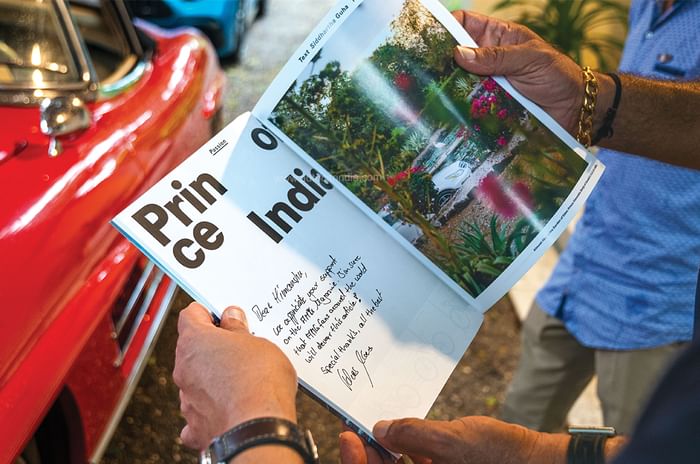
With the light clutch and precise gearbox that clack-clacks through, driving the 300 SL at slow speeds is an absolute joy. It’s easy to drive in a smooth but rapid manner with the strong bottom end, and what helps is that this dry sump engine even loves to rev. The M198 is a race car-derived engine after all. The car gathers speed effortlessly, almost like it is using more throttle than you are asking it to, and as I pull it harder, there’s a distinct step up in performance after 4,500 rpm. Nicer still, the engine even smoothens up and loves the high revs. Cars of the era, please remember, barely did 4,500rpm at max. The cherry on top is that along with a step-up in performance comes a new harder-edged blare from the exhaust, one reminiscent of Merc’s straight-eight Grand Prix titans of the ‘30s.
Before I know it, we cross 110 miles on the speedometer and what feels even more nuts is that now with the bit between its teeth and clearly on cam, the 300 SL just wants to go quicker and quicker.
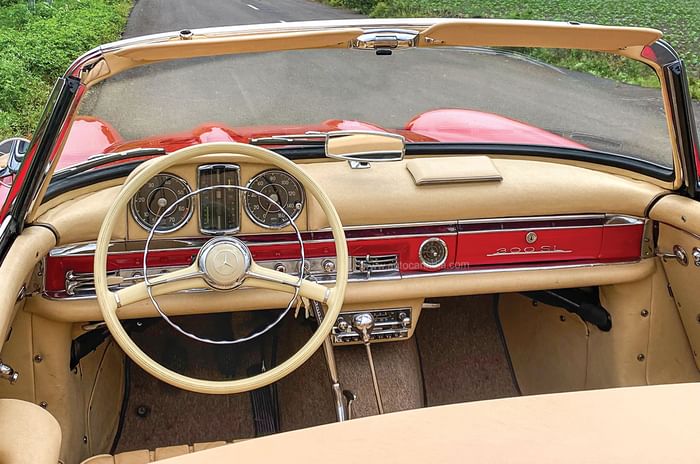
While the pace of the car is similar to that of something like a modern Octavia, the brakes are still rooted in the past. Sure, the finned drum brakes must have been fabulous back in the day, but today, retardation is less than half of what you expect, and I need to use much more pedal effort.
When it comes to taking corners, the 300 SL is clearly much softer around the edges than a modern sportscar. The ride is very comfortable, it’s easily several times more absorbent than the SL 55 and better suited to our conditions, and what makes it so much more useable is that it has enough ground clearance to climb over even the tallest speed breakers.
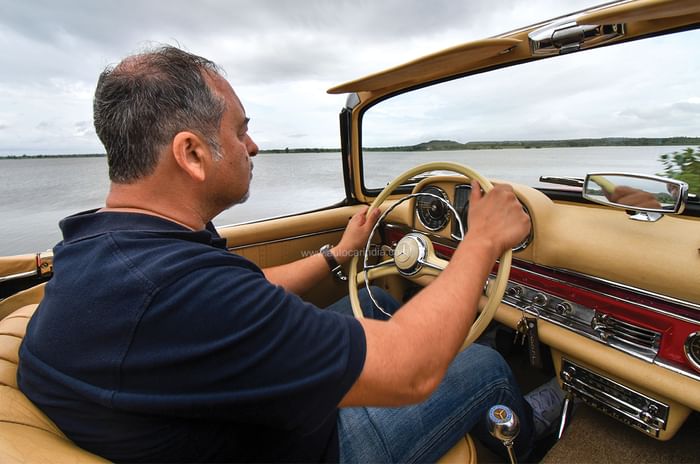
Slinging it along the country roads at a fair lick, however, is a very different affair. The steering has much more slack, it rolls a lot more as you enter corners and there is a fair amount of flex from the chassis. So I need to drive it differently. I have to brake firmly, but not hard enough to upset the balance of the car, I have to be ready to make micro corrections to my line after I turn in due to the vague steering, and then I allow the roll to settle down before getting back on the responsive throttle and unleashing upwards of 200hp.
What’s amazing is that there’s not too much pitching despite the huge overhangs. It feels balanced and grippy in corners once I get used to the steering, and what allows me to actually take corners with greater confidence is that it feels well-balanced. It still feels quick today; so quick I struggle to keep up with Himanshu later in the day as we swap back and he’s driving his own car.
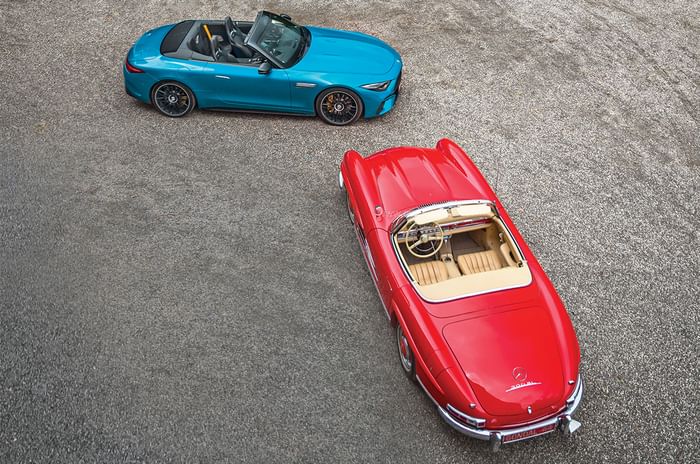
Our drive ends at a picturesque man-made lake, where we sort of race to see which car’s hood goes up faster. The manual hood on the 300 SL is well-engineered and simple to operate, and nearly as quick as the modern car. Good German engineering. Not so much on the modern car – you need to hold onto a slider on the screen while the hood goes up or down. Problem is the screen seems to have a mind of its own.
Generation X
Despite the wide chasm in time, one thing’s clear, the seventh-generation SL still retains plenty of DNA from the seminal 300 SL. The predominantly two-seater is now back as a soft-top, there’s a new focus on real performance with the aluminium construction and the strong V8, and despite some limitations, the new SL 55 is still a good companion on long-distance trips. Sure, it is expensive at Rs 2.35 crore, and you need to pay extra for the optional nose lift. But buy into the SL myth, hold onto the car for a few years and what you will have is a future classic. One that can draw a line all the way back to the legendary million-and-a-half dollar red car, also on these pages.
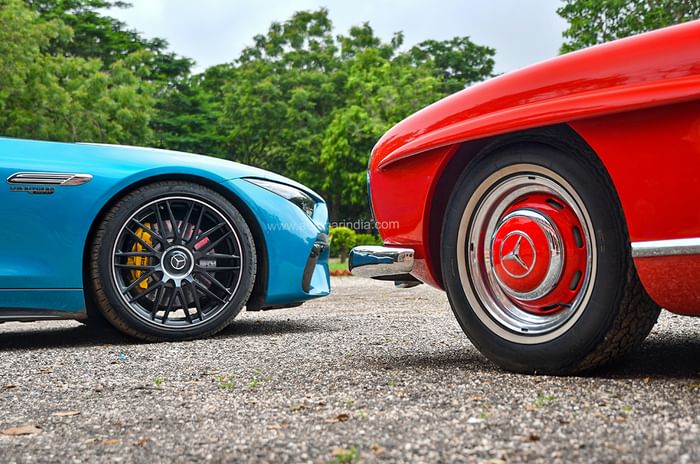
Fit for a king
The Gondal 300 SL is an extremely rare single-owner car, one of only a handful still around. “We’ve actually had it in the family since it was new,” says Himanshu of Gondal with great reverence. “My father (the late Maharaja Jyotendrasinhji of Gondal) chose it over many new Ferrari and Bentley models at the London Motor Show in the ’50s and so my grandfather bought it for him when he was 18.”
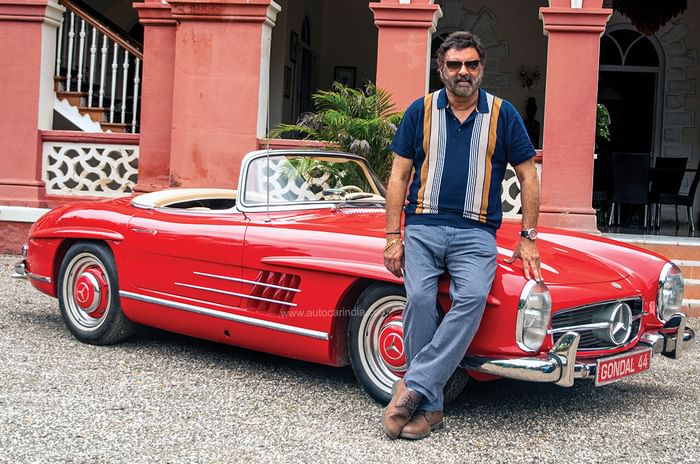
The car took around six months to reach India, but as soon as the running in was completed, it was entered in a race in Pune. The car didn’t stop entering and winning races till 1966, with regular races in Pune, Bengaluru and Chennai. This 300 SL incredibly never lost a single race.
To prep it for racing, the car was lightened. The bumpers and windscreen were removed, and extra oil was added. The engine could be run with eight litres, 11 litres or 14 litres in the reservoir, the latter recommended for racing.
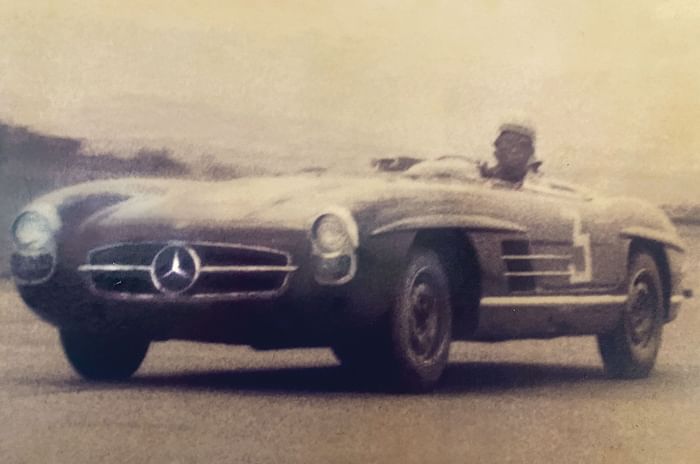
300 SL: Race car for the road
In the ‘50s, Mercedes only had a three-litre, six-cylinder engine.Rivals had both larger and more powerful V8 and V12s. So, to enable it to compete, Mercedes’ legendary engineer Rudolf Uhlenhaut used three important tricks to give the SL some raw pace. He used fuel injection to bump the power and make the engine more dependable, he massively stiffened the chassis to make the car corner faster, and then to increase top speed he designed the most slippery shape of its era. The latter was done by spending a lot of time in wind tunnels, of which there were many in post-war Germany. He even tilted the tall engine over by 50 degrees for a low bonnet line. To increase stiffness, stout tubes were placed where you normally have doors, giving birth to Gullwing doors. And, finally, fuel injection was used for the first time on a car to increase power. Daimler-Benz and Bosch had already mastered the technology in the ’30s on aircraft engines, so it worked like a treat. Later 300 SL roadsters were not quite as slippery through the air but they had a lot more power, so the raw pace was still there.

| Mercedes Benz 300 SL roadster (W198 II) | |
|---|---|
| Year | 1958 |
| Price | $1.5 million* |
| Length/ Width/ Height | 4570/1790/1300mm |
| Wheelbase | 2400mm |
| Engine | 2996cc, straight six |
| Max power | 225hp |
| Drive layout | Rear-wheel drive |
| Gearbox | 6-speed manual |
| Weight | 1560kg |
*Estimated without import duty
| Mercedes-AMG SL55 | |
|---|---|
| Year | 2023 |
| Price | Rs 2.35 crore |
| Length/ Width/ Height | 4705/1915/1359mm |
| Wheelbase | 2700mm |
| Engine | 3982cc, twin-turbo V8 |
| Max power | 476hp |
| Drive layout | All-wheel drive |
| Gearbox | 9-speed automatic |
| Weight | 1950kg |






































